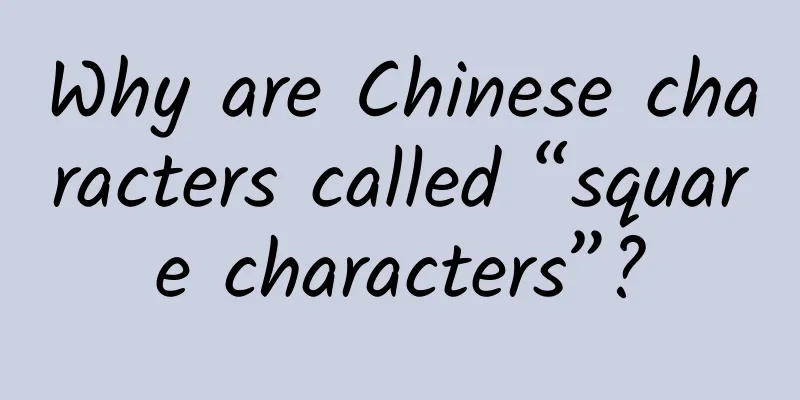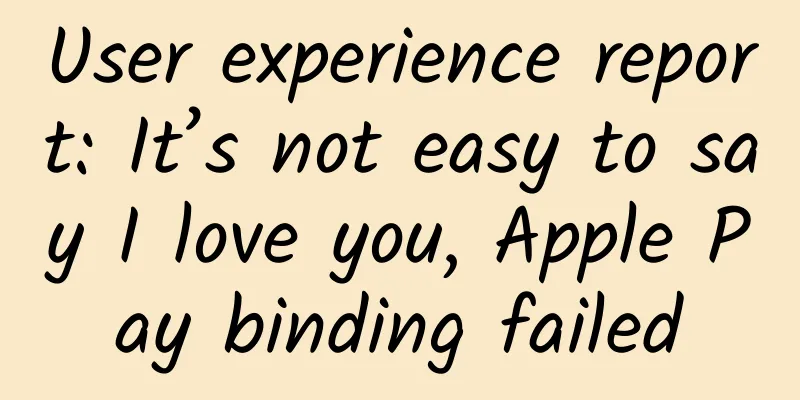Why are Chinese characters called “square characters”?

|
In the history of Chinese characters, people usually refer to the seal script and pictographic characters handed down before the Qin Dynasty as "ancient characters", and the official script and the characters that appeared later as "modern characters". Therefore, the "official script change" became the dividing line of the evolution of Chinese characters from ancient characters (ancient characters) to modern characters (modern characters). Tracing back to the source, this change is somewhat related to the writing medium of Chinese characters. What is "Jiandu"? The so-called "jiandu" is a general term for bamboo and wood used for writing. Generally speaking, bamboo is called "jiance"; wood is called "bandu"; but there are also wooden ones. Specifically, a piece of bamboo is called "jian", and several pieces of bamboo are called "ce", also called "ce". In the "Shuowen Jiezi" of the Eastern Han Dynasty, "ce" is a pictograph, which looks like a long and a short one, with two "bundles" in the middle. A jian cannot hold many words, and long articles must be made of many jians. The rope used to make a ce is called a "bundle", which is generally made of hemp rope, but there are also leather ropes or silk ropes to connect single jian. A piece of wood is called a "ban", and words written on it are called "du". If it is a one-foot square slab, it is called a "fang". Generally, short articles of less than 100 words can be written on a bandu, and long articles are written on a jiance. Blocks were mainly used to record the names of items or register household registration, compile maps and communicate, so the ancients often used "block" to represent the country's territory. From common sense, we know that it is not easy to write on ordinary bamboo and wood, so "bamboo slips" have to go through a processing process. Wang Chong of the Eastern Han Dynasty introduced in his book "Lun Heng": "Bamboo grows in the mountains, wood grows in the forest, bamboo is cut into slips, broken into pieces, and with the addition of pen and ink, words are formed", "wood is cut into tablets, split into boards, and scraped and polished to form slips". This means that bamboo is cut into tubes, split into strips; wood is sawed, split into boards, scraped and polished, and then words can be written on. It is impossible to verify when bamboo and wood were used for writing, but it must have been very early. The Book of Documents states: "Only the ancestors of the Yin Dynasty had classics and books." In addition, the word "book" can be found in oracle bone inscriptions and bronze inscriptions, which means that bamboo slips existed before 1300 BC at the latest. Unfortunately, due to the perishability of bamboo and wood and the long history, the Yin and Zhou bamboo slips buried underground have long since rotted away, and no real objects have been found so far. The earliest existing bamboo slips are the Warring States bamboo slips unearthed from the Zenghou Yi Tomb in Hubei (433 BC), with a total of more than 240 pieces and about 6,000 characters. In December 1975, more than 1,100 bamboo slips were unearthed from Tomb No. 11 of Shuihudi in Yunmeng County, Hubei Province. The contents included documents of the governor of Nanjun, records of major events, ways of being an official, and laws. Some people may ask, how did the ancients write on "bamboo slips"? Since they are made of bamboo and wood, were the words carved with a knife? This is not the case. According to the unearthed objects, the characters on the bamboo slips were written with a brush and black ink. If a wrong character was written, the ink was scraped off with a knife, and then the correct character was written. Therefore, the revision of an article has always been called "deletion". According to the unearthed objects, most of the writing knives are made of iron, with straight blades and ring-shaped handles. Because the writing knives were used to correct wrong characters, similar to the current erasers, the ancients often carried knives and pens with them when writing, so that they could correct mistakes at any time. The writing knife was as important as the brush in the writing of the bamboo slips era. The long-term use of knives and pens made "knife and pen" finally condensed into a word and had a special meaning. There is a sentence in "The Strategies of the Warring States·Qin Strategies Five": "When I was young, I was a Qin knife and pen, and I was an official but held a small official position. I have never been the head of the army." "The Book of Han·Zhang Tang Biography" also said: "Tang had no merits, and he started as a knife and pen clerk. Your Majesty was fortunate to be promoted to the position of the Three Dukes, and I have no way to avoid responsibility." In all of them, "knife and pen (clerk)" is used as a nickname for a small clerk who handles documents and minutes. Since the Song and Yuan Dynasties, people have specifically called lawyers' staff "刀笔隶". As the name suggests, it means that they are well versed in legal rules, have sharp writing skills, and use their pens like knives. Zhubutu, Eastern Han Dynasty, unearthed from Tomb No. 1 in Wangdu County, Hebei Province in 1952 In order to write on bamboo slips, ancient people usually knelt on the ground, holding the slips with their left hands and writing with the pen with their right hands. In the murals of the Han Dynasty Tomb in Wangdu, Hebei, there is a "Master Recorder" and a "Master Bookkeeper" sitting and writing opposite each other, which more realistically reflects this writing method. In the picture, the Master Bookkeeper is sitting on a table (or couch), holding a slip in his left hand and a pen in his right hand, making notes. Bamboo slips are all long and thin. When writing, there are two options: horizontal or vertical. However, the ancients thought that vertical is more appropriate: when the bamboo slips are placed vertically, the left hand holds the slip with the palm as support and uses five fingers to hold the slip, which makes the bamboo slip stable and convenient for writing; when the bamboo slips are placed horizontally, the left hand can only hold the left end of the bamboo slip, which is easy to shake when writing. After writing a slip, the left hand takes the next slip. In order to avoid disrupting the order of the written slips, the blank slips to be written are usually placed on the left hand side, and the written slips are arranged from right to left in sequence, with the first one written on the rightmost. After the writing is completed and the slips are compiled into a book, the title of the book must be written on the first slip. Sometimes, in order to protect the slips, two blank slips are added at the beginning, which are called "superfluous tubes". This is also the source of the "protective seal" of books in later generations. When a book was finished, it was rolled up with the last bamboo slip as the central axis for preservation. To avoid confusion, the bamboo slips of the same book were often stored in "帙" or "湘". This formed the habit of writing Chinese characters from top to bottom and from right to left, which lasted until long after paper replaced bamboo slips. Some ancient books published today still have vertical text, which follows this historical "inertia". How many characters can be written on a bamboo slip? According to the analysis of a large number of unearthed bamboo slips, the length of the slip is not absolute. The general rule is that the length of the slip is closely related to the content of the writing. For important books or important events, the longest slip must be used to write. The number of characters written on each slip is different, with only one or two characters, a few characters, a dozen characters, or even dozens of characters. Each slip only has one column (wider wooden slips can have two or more columns). Compiling a complete book usually consumes a large number of slips, and it is also necessary to avoid the loss of content and the reversal of order after the slips are damaged during the circulation process. When the pages and lines of a book are disordered, the proofreader calls it "wrong slips", indicating that the order of the slips is disordered. Bamboo slips from the Warring States period, unearthed from the Zenghouyi Tomb in Sui County, Hubei Province, now in the Hubei Provincial Museum Since bamboo slips, a vertically narrow writing medium, have long dominated the pre-Qin period, writers were unable to make large movements when controlling the brush and could only be confined to a narrow space. A contradiction was formed between the size of the bamboo slips and the amount of information in the written text, forcing people to express themselves in concise language as much as possible when writing, and to try to write more text in a small space. To achieve this goal, the characters must be flattened to save vertical space. In order to ensure the clarity of the text, the limited width of the bamboo slip surface must be fully utilized to stretch the text to the left and right sides as much as possible. Under the combined effect of vertical compression and horizontal extension, a unique layout form with a flattened single word and a widened spacing between the upper and lower words finally appeared, which is the so-called "official script". The Origin of "Libian" The rise of "Lishu" was roughly between the late Warring States period and the Qin and Han dynasties. This period was also the period when bamboo slips developed most rapidly and were most widely used. At that time, the Qin State advocated Legalism and had complete laws and regulations. For example, the Qin slips unearthed from Shuihudi included the "Eighteen Qin Laws", which covered agriculture, warehouses, currency, trade, corvée, officials, military ranks, handicrafts and many other aspects. With such a complex legal system, clerical work naturally became very busy. Therefore, in the process of writing Qin characters during the Warring States period, a large number of popular characters had been formed in society. Many of the characters on the large number of Qin slips discovered in recent decades are obviously not regular seal characters ("Qingchuan Haojiaping Wooden Slips", "Tianshui Qin Slips", "Yunmeng Shuihudi Qin Slips"). After the Qin Dynasty unified the country, the Xiaozhuan script became the common writing. Unfortunately, although this mellow and handsome writing is simpler than the previous writing, its long curved lines of the same thickness are still difficult to write. Due to the busy government affairs, the "slaves" who handled ordinary documents in the government offices needed to be quick and used the folk fonts to simplify the seal script by themselves. This is probably how the name "official script" came about. There is a sentence in "Book of Jin·Biography of Wei Heng", "Official script is the shortcut of seal script", which points out the characteristics of official script: the quick writing of seal script is official script. There is also a saying that the emergence of "Lishu" is attributed to Cheng Miao. It is said that this person was originally an official in the Qin court. Later, he offended Qin Shihuang for some reason. Qin Shihuang put him in prison for ten years. In prison, he collected and sorted out the cursive seal script popular among the Li people at that time, and presented these 3,000 characters to Qin Shihuang. After seeing these, Qin Shihuang was very happy and released Cheng Miao from prison. But this statement was questioned as early as 15 centuries ago. Li Daoyuan's "Water Classics" in the Northern Wei Dynasty (386-535) quoted Sun Changzhi's words, pointing out that people in Linzi, Shandong, excavated an ancient tomb and found a bronze coffin called Hu Gong, the sixth grandson of Qi Taigong. There are only three ancient characters on it, and the rest are the same as Lishu, which can prove that Lishu did not start in the Qin Dynasty. Perhaps, just like Li Si sorted out the small seal characters, when the Qin government officially used Lishu characters, official clerks like Cheng Miao had done systematic sorting work and played an important role in the formation of Lishu. Jianshui Jinguan Signboard, Eastern Han Dynasty. Excavated from the Jianshui Jinguan Site in Gansu Province, now in the Gansu Museum of Bamboo Slips. The four characters "Jianshui Jinguan" are in the official script used in official documents of the Eastern Han Dynasty. Regardless of its origin, Lishu was clearly a vulgar script used by lower-level scribes. Although the Qin rulers allowed officials to use Lishu to handle daily affairs - in 1975, two jade seals with the same text were found in Qin Tomb No. 70 at Fenghuang Mountain in Jiangling, Hubei: one was regular seal script; the other was consistent with the official script style of Qin bamboo slips - "Xiaozhuan" was generally used instead of "Lishu" for more solemn occasions. Qin Shihuang traveled around the world and carved stones everywhere, all in Xiaozhuan font, which is proof of this. Xiaozhuan was created during the Qin Dynasty, and Lishu was also developed. Perhaps compared with Lishu, Xiaozhuan was not very practical and difficult to write, and was far inferior to Lishu, which was developed at the same time. Therefore, Xiaozhuan became a short-lived script and soon withdrew from the stage of history. In the Han Dynasty, Lishu finally replaced Xiaozhuan and became the official writing font. Two square copper seals with the word "Lengxian" in Chinese, unearthed from the Qin Tomb at Fenghuang Mountain in Jiangling during the Qin Dynasty. The two characters "Lengxian" on the seals are written in small seal script (right) and official script (left). The evolution of Chinese characters from seal script to official script is called "official script change". The change from seal script to official script is an important turning point in the history of Chinese character evolution and a watershed between ancient and modern Chinese characters. Xu Shen in the Eastern Han Dynasty said in "Explanation of Shuowen Jiezi": "Qin burned and destroyed the classics, eliminated the old classics, and sent a large number of soldiers to serve as soldiers. Official duties were complicated, and the official script was first used to make it interesting and simple, and the ancient characters were lost." His words were obviously spoken from the standpoint of defending ancient characters. Compared with the previous seal script, the most notable feature of official script is that it "breaks the circle into a square": the curved lines of small seal script are changed into straight strokes, and the round strokes of small seal script are changed into square strokes. Such changes seem to be related to the writing medium. Small seal script is usually applied on stone with a knife, so when writing small seal script, all strokes are written with a round brush, and there is almost no lifting and pressing action of writing with a brush, and the strokes are straight and of equal thickness; while official script is written with a brush on bamboo slips, and the writing can show the varied brush strokes, with both square and round strokes and rich thickness changes. The origin of this writing style may be related to the texture of the bamboo slips. Even if the surface of the bamboo slips is flat, its lines are still evenly arranged vertically and have grooves. Therefore, the resistance encountered by the brush when writing horizontal strokes and vertical strokes is different. When the brush writes vertical strokes from top to bottom on the slip, the resistance encountered is relatively uniform, while when writing horizontal strokes from left to right, the brushstrokes must be adjusted. When encountering resistance, the brush tip is consciously pressed down, and then the brush tip is lifted after passing through, thus forming an upward trend. Such a "silkworm head and goose tail" horizontal stroke often appears only once in each character. Even for characters with many horizontal strokes, it only appears once in its main stroke and not in the other strokes. This is the so-called "silkworms do not arrive twice, and geese do not fly in pairs." This exaggerated main stroke enhances the visual impact and is clear and easy to recognize. Therefore, there is a clear boundary between characters. For bamboo slips with relatively casual writing, uneven font sizes and unclear spacing, it is undoubtedly an important means of marking between characters. "Silkworm head and goose tail" has also become the most prominent feature of mature "Lishu". The Golden Age of Lishu In fact, the changes of official script to ancient characters are more than that. Some people have summarized the following rules of change: 1. Deformation. Deformation means that the shape structure of the font remains basically stable in its original state, and only the curves of the seal script are changed into straight and square strokes, so that the image of the font changes; 2. Simplification. Simplification means that while the deformation occurs, the traditional characters are simplified and some of the partial heads are omitted. For example, the upper parts of the characters "秦、春、奉" are different in the seal script, and they are replaced by the same new component after the official script is changed; 3. Corruption. Corruption means that while the deformation occurs, the direction of the strokes and the order of the strokes are changed, so that the shape structure of the characters also changes and the shape of the characters is reorganized. For example, the two "火" characters under the character "黑" are differentiated into "土" and "四点", and the character "光" changes the "火" character above into "小", and so on. Through such changes, the vast majority of Chinese characters have become symbols that have completely lost their pictographic meanings, and are composed of dots, strokes, left strokes, and right strokes. Irregular lines have become regular strokes. From the perspective of character shape, through merging, omitting, and omitting, the shape of Chinese characters has been greatly simplified and has become a completely symbolic text. No wonder "An Outline of Chinese Character Studies" summarizes it this way: "The transition from seal script to official script is a major leap in the history of Chinese characters. From then on, Chinese characters completely lost the pictographic meaning of the ancient writing stage, got rid of the constraints of the winding lines of the ancient writing, and began to enter the modern writing stage." In the Han Dynasty, except for seals (letters, contracts and seals), banners (flags with official titles and positions), and some tablets and bricks and tiles, official script was widely used in other occasions. At that time, writing official script had become a social trend, and writing good official script was a means to enter the officialdom. There was a proverb in society: "Why bother with etiquette and morality, and become an official by writing history books." It means why bother with "etiquette and morality"? If you can write good official script (called "history books" by people in the Han Dynasty), you can become an official. This of course greatly promoted the development of official script. In the fourth year of Xiping reign of Emperor Ling of the Eastern Han Dynasty (175), Cai Yong (father of Cai Wenji), a famous writer and calligrapher at that time, suggested to fix the texts of the seven classics, including "Lu Shi", "Shang Shu", "Zhou Yi", "Chun Qiu", "Gong Yang Zhuan", "Li Li" and "Analects of Confucius". A total of 46 stone tablets were carved and erected in front of the Imperial College, known as the "Xiping Stone Classics". The characters on the Xiping Stone Classics are all in the same style, with square shapes, symmetrical strokes, neat strokes, and solemn and elegant style. In the late Eastern Han Dynasty, it was used as the standard style of official script, known as the "Bafen" style. At this point, the evolution of "official script" was basically completed. A Ming Dynasty rubbing of the Yiying Stele (partial), now in the collection of the Palace Museum The subsequent "Cao Quan Stele", whose full name is "Han Heyang Ling Cao Quan Stele", also known as "Cao Jingwan Stele", was completed on October 2, the second year of Zhongping in the Eastern Han Dynasty (November 30, 185). There are 20 lines on the front of the stele, 45 characters per line, and 33 lines of inscriptions on the back of the stele, divided into 5 horizontal columns, which record the achievements of Cao Quan (Zi Jingwan). Its calligraphy is elegant and graceful, and the characters are evenly formed, with both square and round. Wan Jing, a calligrapher in the Qing Dynasty, commented that "it is beautiful and flying, not bound or rushed, and it is truly a divine work." Only one year after the "Cao Quan Stele", another famous stele in the late Han Dynasty, "Zhang Qian Stele" (full name "Ode to Zhang Qian, the Governor of Gucheng Dangyin"), was carved in the third year of Zhongping in the Eastern Han Dynasty (186). The writing style of this stele is different from that of the Cao Quan Stele. It is mainly square in shape and has sharp edges and corners. Among the many famous Han steles, the Zhang Qian Stele can be said to be the "last glorious one". Not long after, the country was in chaos and the court had no time to take care of the matter of erecting steles and writing biographies. Later, Cao Cao issued an order to ban steles, and the trend of erecting steles that had been popular since the reigns of Emperor Huan and Emperor Ling fell into a low ebb. At the same time, the official script engraved on the stone stele also had a similar fate: "The style of official script is largely based on the writing requirements of a specific writing material - bamboo slips, so it is horizontal. However, the horizontal style does not meet the high efficiency requirements of general writing occasions. Therefore, once the writing material of bamboo slips is removed, there is no reason for the style of official script to remain unchanged. The development and changes of facts are in accordance with the provisions of this logic." A Ming Dynasty rubbing of the Zhang Qian Stele (partial), now in the collection of the Palace Museum References: Zhu Renfu: "History of Chinese Calligraphy", Wu Lingfang and Qian Wanli: "History of Chinese Books", Chen Fangyi: "Good Work, Good Tools: The Influence of the Evolution of Writing Tools on the Development of Fonts", etc. |
<<: Are the bamboo shoots eaten by giant pandas actually poisonous?
>>: The main culprit of holiday syndrome is a drop in adrenaline secretion! Is that all?
Recommend
Query the price of joining Zhangbei Luggage Mini Program. How much is the price of joining Zhangbei Luggage Mini Program?
For entrepreneurs, although mini program developm...
Two NBA Lakers players diagnosed with COVID-19, Celtics player Smart also infected!
According to Shams, a famous reporter from the Am...
B station advertising account opening process, B station advertising display
The information flow ads on Bilibili are placed a...
Opening a new door to green pesticides: A new type of fungicide that "kills rice cancer" is born!
Rice blast, also known as "rice cancer"...
32 amazing cross-sectional images revealing the unknown side of things
There is an old saying that goes, "It is eas...
Wake up! It's time to go to work! This guide to getting back to work is specifically designed to treat "post-holiday syndrome"
With the end of the May Day holiday, everything i...
In addition to the Northeast giant orange, are there any other "tigers" with outstanding combat capabilities?
The Year of the Tiger is here, and all kinds of p...
How to do search engine bidding promotion?
Internet website building and marketing has been ...
Korea Customs Service: South Korea's chip exports in October 2022 were US$5.28 billion, down 29.4% year-on-year
As an important pillar of South Korea, the amount...
3000 words in-depth explanation of the bidding OCPC delivery & optimization guide!
What I want to talk about today is search OCPC. I...
From ad images to landing pages, 14 tips to improve conversions
This article is a summary of the book "The B...
Are invasive alien species necessarily villains?
Produced by: Science Popularization China Author:...
Kuaishou APP product analysis report!
In this article, I will start with the developmen...
Chongqing flood losses exceed 2.4 billion
Chongqing flood losses exceed 2.4 billion Zou Yu,...
AI is advancing rapidly: Is China ready?
On May 30, at the 2023 Zhongguancun Forum Results...









